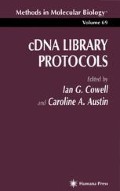Abstract
The phage λgt1.1 system has become increasingly popular for expression of cDNAs or genomic DNAs either in phage plaques or in bacteria lysogenized with recombinant phages (1,2). It offers the advantages of high cloning efficiency, high-level expression, the relative stability of β-galactosidase fusion proteins, and simple approaches to purify the fusion proteins. After the desired clone is detected and purified, it is often necessary to obtain preparative amounts of recombinant protein specified by the fusion of the foreign sequence to the carboxyl-terminus of β-galactosidase in λgt1.1 expression system. The conventional method for preparing fusion proteins from the recombinant λgt1.1 clones involves production of phage lysogens in Escherichia coli strain Y1089 followed by inducing lacZ-directed fusion protein expression with isopropyl-β-D-thiogalactopyranoside (IPTG) (1). This method has two limitations: it is time-consuming, and phage lysogeny occurs at a low frequency. We have previously described a method for making fusion proteins from LB agar plates containing E. coli Y1090 infected with a high concentration of recombinant λgt1.1 phages (up to 5 × 106 PFU/l50 × 15-mm plate) (3). A liquid culture method for preparing fusion proteins from E. coli. Y1090 infected with the λgt1.1 clones has previously been described (4). More recently, some improvements have been made on the plate method by repeating induction and elution (5). Although the liquid culture method allows the recovery of only 0.2–1% of total proteins (6,7), this method generally yields 5–10% of expressed protein in solution, that is, most lysed cells are trapped in the agar and the expressed proteins are recovered in a small volume of inducing solution, resulting in a higher final concentration of protein. More than 200 µg of fusion protein can be obtained from one plate. Currently, the plate method appears to be a simple and efficient way to express and prepare fusion proteins from recombinant λgt1.1 phages (Figs. 1 and 2). This chapter describes how the β-galactosidase fusion proteins can be made and isolated from the recombinant λgt1.1 phages with the plate method.

Induction of the 190-kDa ERP72 fusion protein with various concentrations of IPTG (lane 1, no IPTG; lane 2, 2.5 mM; lane 3, 5 mM; lane 4, 10 mM). Fusion protein was detected by Western blot analysis with anti-ERP72 antibody (8).

Repeated induction and elution of the 190-kDa ERP72 fusion protein from agar plates. E. coli Y1090 cells were infected and plated by the procedure described in Section 3. Plates were incubated for 3 h at 42°C and 5 mL of 5 mM IPTG in 0.5X LB containing 10 mM MgSO4 added to each plate. Incubation was carried out at 37°C for 3 h (lane 1), and the supernatant saved. Induction and elution were repeated five times with 1-h intervals between inductions (lanes 2–6). Fusion proteins recovered after each induction was analyzed by Western blotting.
Access this chapter
Tax calculation will be finalised at checkout
Purchases are for personal use only
References
Mierendorf, R. C., Percy, C., and Young, R. A. (1987) Gene isolation by screening gt1.1 libraries with antibodies. Methods Enzymol. 152, 458–469.
Young, R. A. and Davis, R. W. (1991) Gene isolation with λgt1.1 system. Methods Enzymol. 194, 230–238.
Huang, S. H., Tomich, J., Wu, H. P., Jong, A., and Holcenberg, J. (1989) Human deoxycytidine kinase: sequence of cDNAs and Analysis of Expression in cell lines with and without enzyme activity. J. Biol. Chem. 264, 14,762–14,768.
Runge, S. W. (1992) Rapid analysis of λgt1.1 fusion proteins wlthout subcloning or lysogen induction. BioTechniques 12, 630–631.
Huang, S. H. and Jong, A. (1994) Efficient induction and preparation of fusion proteins from recombinant λgt1.1 clones. Trends in Genetics 10, 183.
Promega (1991) Promega Protocols and Applications Guide, 2nd ed. Madison, WI.
Singh, H., Clerc, R. G., and LeBowitz, J. H. (1989) Molecular Cloning of sequence-specific DNA binding proteins using recognition site probes. BioTechniques 7, 252–261.
Huang, S. H., Gomer, C., Sun, G. X., Wong, S., Wu, C., Liu, Y. X., and Holcenberg, J. (1992) Molecular characterization of a 72-kD human stress protein: a homologue to murine ERP72. FASEB J. 6, A1670.
Author information
Authors and Affiliations
Editor information
Editors and Affiliations
Rights and permissions
Copyright information
© 1997 Humana Press Inc., Totowa, NJ
About this protocol
Cite this protocol
Huang, SH., Jong, A. (1997). Expression and Preparation of Fusion Proteins from Recombinant λgt1.1 Phages. In: Cowell, I.G., Austin, C.A. (eds) cDNA Library Protocols. Methods in Molecular Biology™, vol 69. Humana Press. https://doi.org/10.1385/0-89603-383-X:241
Download citation
DOI: https://doi.org/10.1385/0-89603-383-X:241
Publisher Name: Humana Press
Print ISBN: 978-0-89603-383-2
Online ISBN: 978-1-59259-555-6
eBook Packages: Springer Protocols

